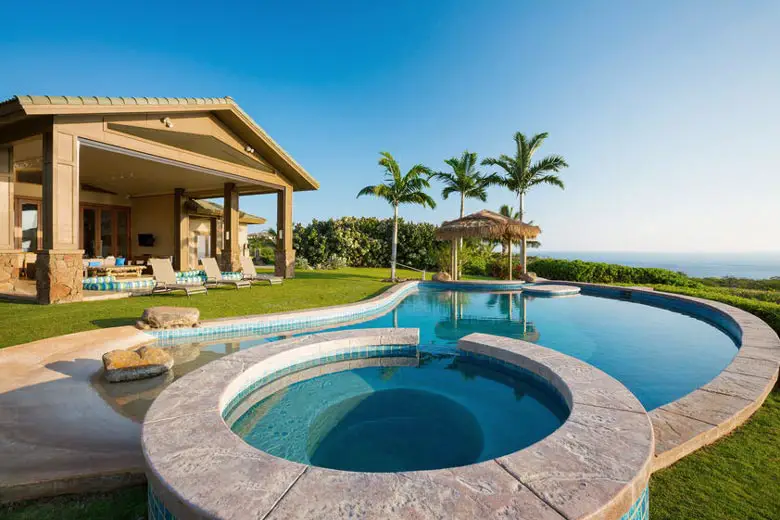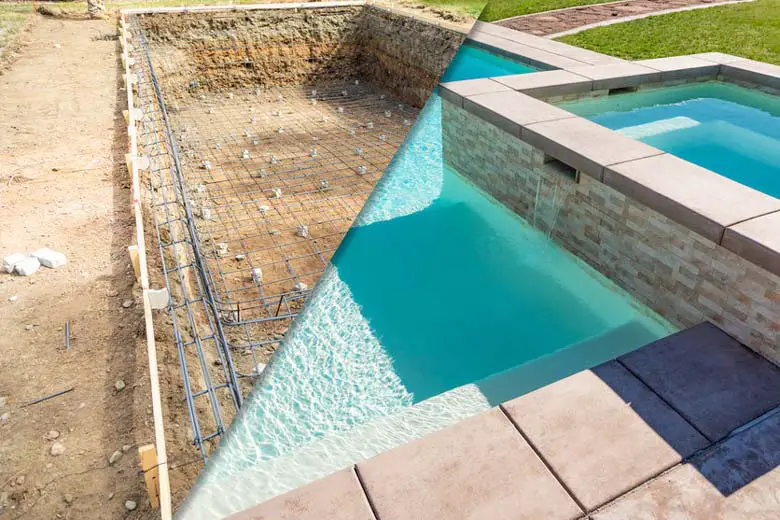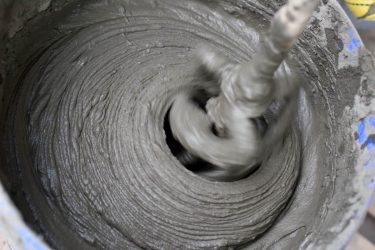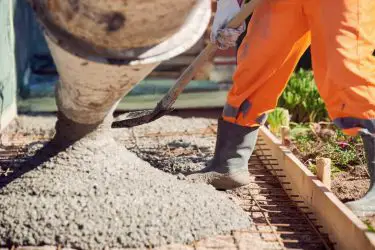Most of the best quality pools are made of concrete, and they can last for several years before repairing your pool is needed. It can take 3–6 months to complete a pool, depending on its size and construction complexity. Most cities won’t allow you to build a pool yourself, but it’s worth learning how concrete pools are made so that you’ll understand the process as you supervise your contractors.
Concrete pools are made using shotcrete (thoroughly mixed wet concrete) or gunite (a dry mix that only gets wet when mixed with water upon spraying via a nozzle). Before concrete is applied, builders will place rebar first. After the concrete is applied, curing will take place for at least 28 days.
Throughout this article, you will learn about building concrete pools and the following:
- What a concrete pool is and what materials used to build it
- The pros and cons of creating a concrete pool
- The duration and cost of the construction
- How concrete pools are made

Table of Contents
What Is a Concrete Pool?
A concrete pool is a pool made of cement, water, sand, and rock. Shotcrete is commonly used to build concrete pools, a wet mix of concrete sprayed on a vertical or overhead surface using a hose at a high velocity.
Gunite can also be used for building concrete pools, but unlike shotcrete, gunite is a dry mix of concrete that gets wet when water is mixed with it at the nozzle upon spraying.
Read more: Gunite vs. Concrete: Here Are the Differences
The result you get from using either method will be the same as long as you do it properly. It can take almost a month for the concrete to dry after spraying. You want to let the concrete mix set between 24 and 48 hours first, and in about 28 days, the curing process should complete.
Concrete is a strong material suitable for building pools. On average, concrete is about 3500 – 4000 psi (pounds per square inch) strong. That’s about the same psi for standard sidewalks or slabs. You must ensure your concrete cures between 28 days and 1 month to achieve this psi.
Adding Rebar to a Concrete Pool
Before applying the concrete, contractors will add rebar to frame the concrete, enabling the concrete to bend. The rebar has to be thick enough to withstand pressure from soil outside of the pool and the water inside the pool.
Usually, the rebar sizes for residential concrete pools are either 11.3 mm, 16 mm, or 19.5 mm.
While concrete is difficult to crush, it is vulnerable to cracks when exposed to its surrounding forces. That is why you need to use rebar to support your concrete.
Your concrete pool’s strength will also be determined by the amount of cement you use — the more cement you use, the more durable the concrete.
How Thick Should a Concrete Pool Be
Ideally, the shell of a concrete pool should be as thick as 6 inches, maybe more, depending on the soil’s condition.
The pool’s plaster must also be at a minimum of ⅜ inch thick. You can see your pool’s thickness within 6 days after adding your rebar and concrete.
As mentioned earlier, a concrete’s average strength is up to 4000 psi. Despite its excellent strength, concrete lacks tensile strength, which means it can easily crack when it comes in contact with gravity, water, or soil. That’s why it is essential to add rebar to the concrete pool.
Sometimes concrete pools can experience cracks, and these cracks can happen on the pool’s surface or from the pool’s inner part.
Cracks on the pool’s surface are known as ‘craze crack’, and they happen due to early surface drying. Although craze cracks won’t leak water, they can cause staining to the pool, promote algae growth, or cause calcium nodules.
When designed properly, a pool should not easily crack. You want to ensure that your pool is well-designed so that it can withstand the soil around it. Over time, soil can expand (due to moisture) and become unstable. A design failure can cause water to leak from the pool.
Pros of Concrete Pools
You can expect high-quality pools when they are made of concrete. Not only do concrete pools look great, but they can also last for a long time. Concrete pools are also customizable, so if you don’t want to go for the traditional pool look, you can opt for a concrete pool that you can customize.
Appearance
One of the main reasons why many people favor concrete pools over other pool types is their classic pool appearance. There is no need to worry about the liner having bubbles, which can happen when groundwater leaks from beneath the pool and goes up to the liner.
Bubbles in the liner usually occur when there’s much rain.
If you care for your concrete pool correctly, you won’t have to worry about algae overgrowing in the swimming pool. Proper concrete pool care can also prevent staining on the swimming pool.
Compared to other pool types, like vinyl liner pools or fiberglass pools, concrete pools require the most maintenance.
Related article: Concrete vs. Fiberglass Pool: The Ultimate Comparison
Customizability
Another reason why concrete pools are popular is their customizability. You can design your concrete pool in any size or shape. The fancier the design, the more money, and effort put into constructing them.
It’s essential to determine what you need your pool for to help you estimate your budget. Is the pool for socializing or exercise? How much space do you have for the pool?
You’ll find many homes or hotels with linear or rectangular pools. With concrete pools, you can opt for a freeform pool, which gives you a tropical look.
Since a pool will be one of your most expensive home upgrades, you want to ensure that you are sure about the pool shape and size you can be happy with years down the road.
It would be great to have different depths within the pool if the size is not a problem. You can have an area where your kids can safely play, about 3 feet or less deep. For swimming, a depth of 3.5 feet or more will be excellent.
Durability
And, of course, durability is essential for any kind of construction. Concrete pools are durable and can take several years before they require crucial maintenance and repair.
Vinyl liner pools are not as strong as concrete because they are vulnerable to sharp objects.
Concrete pools are indeed durable but bear in mind that concrete pools’ plaster is not as durable as their structure.
Due to this weakness, concrete pools tend to be more expensive to maintain than other pool types, such as fiberglass pools. If you want to have a concrete pool for your home, do take note of the pool’s maintenance cost in the long run.
Cons of Concrete Pools
While concrete pools are remarkable for their beautiful appearance, customizability, and durability, they are not the cheapest to maintain. Concrete pools also require a long time to build. And have a rough surface, which might not be to everyone’s liking.
Expensive To Maintain
Concrete pools are more expensive than fiberglass or vinyl liner pools. It isn’t just the building cost that you need to consider, but also the lifetime maintenance. It would be best if you could give your pool a weekly clean to prevent algae from settling into your concrete pool’s surface.
Of course, if you regularly clean your concrete pool, you don’t have to worry about algae growing in your pool.
However, it will be challenging to remove algae that have already settled into your pool’s surface. To prevent algae from settling into your pool’s surface, you need to use a steel brush to brush your pool’s surface at least once a week — it seems like a lot of work.
Sure, you can hire a professional to help you brush your pool’s surface, but it won’t be cheap. You can expect to pay about $500 for a professional cleaning service. It could even cost more depending on the size of the pool.
If the concrete pool has too many algae, they will become more difficult to remove. It may be necessary to kill the algae with a lot of chemicals. This effort requires a lot of time and money.
Concrete pools’ plaster needs to be refinished every 10–15 years because, over time, the water’s salt will dissolve the concrete, shortening the life of the concrete’s interior finishing. The job has to be done by a professional, and that can cost a lot of money.
Owning a concrete pool means that you will spend a lot on chemicals and refinishing.
Time-Consuming To Build
As discussed earlier, the curing process for a concrete pool can take up to a month. It would be best to give your concrete pool enough time to cure to prevent structural failure in the future. Other pool types, such as fiberglass and vinyl liner pools, take several weeks only.
Rough Surface
Unlike vinyl liner pools that are not rough for the feet, concrete pools can be coarse. Chances are, you or your kids could scrape their skin while swimming. On the bright side, the pool’s durability makes up for its rough surface.
Cost and Duration of Building a Concrete Pool
Depending on where you live, a pool could cost you an upfront cost of between $50,000 and $100,000. Bear in mind that you will bear the maintenance cost down the road. The lifetime maintenance will not be cheap, so you must have time for a weekly pool cleaning to reduce your pool’s future maintenance cost.
Read more: Cost of A Concrete In-Ground Pool (With 35+ Real Examples)
You may need to wait for up to 6 months to build a concrete pool. The best time to work on a concrete pool is in spring so that you can have it ready before summer arrives. If you’re concerned about the budget, you may want to consider building your concrete pool in winter.
In winter, you will be able to get the best deals. However, there are risks of snowstorms hitting your area, which can slow down the construction. If you live in a less-stormy area, it may be worth considering a winter installation as it will save you more money.
How Concrete Pools Are Made
Your builders can take up to 6 months to complete your concrete pool, so if you want it to be ready by summer, you may want to consider making it in winter, fall, or spring. Keep reading to follow the process of concrete pool construction.

Choosing the Location and Design
The first thing you do before building a concrete pool is determined where you want the pool to be and what design you want to use for the pool. Many people have their pools in their backyards. You want to ensure you have enough room for your concrete pool, regardless of how big or small it will be.
Concrete pools are customizable, so you can design your concrete pool in any shape you want. The classic rectangle pool design looks simple but excellent and sophisticated. If you’re going to create a tropical look in your backyard, you can go for free form pools.
When preparing the design of your concrete pool, you want to take into account the pool shape, depth, size, patio area, and filtration system. It will be best to build your pool someplace flat to save more money during excavation. Perhaps you want to avoid having your pool too close to trees to prevent leaves from falling into the pool water.
Related article: Pavers vs. Concrete: Which Is Better for a Pool Deck?
Excavation
To build the pool, you need to dig the earth first. You can have your contractors take the soil away from your property or use it for other home projects like landscaping. There will be a lot of earth excavated, so you might want to consider selling off the topsoil.
The excavation process can take several hours and up to 2 weeks, depending on the weather, soil moisture levels, pool size, natural obstacles (like branches), or exposed pipes or cables. It would be helpful to share with your excavators some concerns before the excavation:
- How long will the excavation take?
- What can you do to prepare your backyard for the excavation?
- Will the excavation bother your neighbors?
- What to do with all the dirt dug?
Rebar Placing
Before applying concrete, pool builders will place rebar, mesh reinforcing steel bars for strengthening the concrete, which can take 2 days to apply. Rebar is essential for concrete pools as it provides support to the concrete faced with its surrounding elements. Concrete has a weak tensile strength, which means it is prone to cracking.
The rebar will enable the concrete to move with its surroundings, thanks to its flexibility. With the rebar, you can be sure that your concrete pool will not have structural problems that can cut its life expectancy. Rebar is also commonly used in roads, driveways, and commercial and residential buildings.
Read more: Here’s Why Concrete Needs Reinforcement
Plumbing
After placing the rebar, builders will proceed to the pool’s plumbing. Some builders will do plumbing first before the rebar process. Builders will do the plumbing after the rebar phase if they’re using plumbing supported by rebar.
During the plumbing phase, builders will install the pipe for circulating the pool water. The builders will also check the plumbing pressure when the pool’s concrete shell is applied. The plumbing phase can take up to 2 days.
Applying the Shell
The builders will apply concrete using shotcrete or gunite and then shape the concrete using trowels. It can take between 1 and 2 days to see the pool shape. Once the pool is shaped, the builders will wait for the concrete to cure.
Curing
The concrete pool will need at least 28 days to cure properly. During the curing process, the water hydrates the cement, and the longer you let the concrete cure, the stronger it gets. However, if rain falls on the concrete during the curing process, the concrete will take more time to cure.
Read more: Time for Concrete Pools to Cure: When can you fill with water?
You can cover the entire pool using a plastic sheet for 5 days. Place the plastic sheet flat on the concrete and secure it with heavy objects. You could use bricks to hold up the plastic sheet.
Alternatively, you can spray water on the concrete 3–4 times a day to keep the concrete moist. You can also use a damp hessian over the concrete. Add water to the cover from time to time to prevent it from drying out.
Waterproofing
After curing, it is essential to waterproof the pool shell, which can take between 1 and 3 days. Pool builders will smooth out the shell if it is rough and then clean it. Then, the builders will apply the waterproof material to the pool shell.
It’s crucial to keep two things in mind when waterproofing concrete pools: groundwater and pool water. You want to ensure that the pool water containing chlorine won’t affect the pool’s structure in the long run. That said, waterproofing is critical when preparing a concrete pool.
Epoxy-cement systems are popular waterproofing solutions today that can be used as a waterproof layer to protect concrete from moisture. Winpaint 5AC is used to give protection to the surface. The product can withstand chlorine or harmful agents.
Tiling and Coping Installation
After waterproofing, the builders will add tiles along the top of the pool, about 6 inches. Tiling is essential to prevent the concrete pool surface from staining at the waterline. Coping, a material for capping the pool shell, is then done around the pool’s perimeter.
The coping separates the pool area from the patio. Concrete or stone is commonly used for pool coping. Your builders can take up to 3 weeks to complete both tiling and coping.
Patio Installation
You’ll likely spend more time on the patio area than inside the pool, so you want to create a patio area that looks good and spacious enough for your needs. Pool patios typically use concrete, stone, brick, or wood. Patio installation can take between 1 and 2 weeks.
Plastering
During the plastering phase, builders will apply the pool’s interior surface, which can take a day. The builders apply the plaster by shooting it to the pool shell using a hose. Then, the builders will use trowels to smooth out the finish.
Starting Up the New Concrete Pool
Before you can happily swim in the pool, you cannot turn on the pool heaters until you have gotten rid of all the plaster dust from the pool surface. It is necessary to give the pool a brush twice a day to get rid of all plaster dust. You must wait for 48 hours before adding chlorine to the pool water.
It would be best if you made sure that the water is balanced correctly. Your builders will do this for you first, and you will do it subsequently. Your pool will take 10 days to start up.
To add water to the pool, you can use the nearest water source and water it via a hose. Using your home water hose can be slow and daunting, so you might want to consider renting a water truck to speed up the job. Filling up the pool using a water hose from the tap may also require a lot of electricity.
Popular Pool Designs
There are many different pool designs to suit a particular location. The shape of your pool will be heavily influenced by:
- What you need it for
- How many family members can swim together in it
- Where the pool will be
- How much space you have for the pool
Concrete pools are so cool because they can be customizable so that you can design your pool in whatever shape suitable for your home.
Freeform Pools
Freeform pools are the opposite of the traditional rectangular pool, irregularly shaped to match the space around it. At first glance, freeform pools don’t look like swimming pools; more like ponds. Typically, freeform pools have a tropical look and feature a small kiddie pool within it, and sometimes a waterfall.
The first freeform pool was constructed in California, and the pool design became a hit ever since. Freeform pools are ideal for homes with curvy features, so if your doors or windows aren’t square or rectangle, the pool will complement them and the entire aesthetic of your home. For those with a home with squared features, perhaps building a freeform pool a little further away from the house would be ideal — that is, if you have a large backyard.
Rectangular Pools
Rectangular concrete pools may look dull, but they are sophisticated and ideal for minimalist home designs. You can find many rectangular pools in indoor settings. If you plan to use your concrete pool for exercising, rectangular pools will be great for you to practice on those butterflies or chest strokes.
Figure 8 Pools
Figure 8 is one of the most popular pool designs in residential areas because this hourglass design allows water to flow freely, and it gives the swimmer a sense of relaxation.
You can even find natural figure 8 pools in New South Wales, Australia, which have become a popular tourist spot despite their hazards. Sure, a figure 8 pool resembles the number 8, but one end of the pool doesn’t necessarily have to be the same size as the other end — it’s OK if one side is bigger than the other.
Circular Pools
Although generally, they don’t look big, circular pools are popular among homeowners who want a pool on a budget. The circle shape of the pool is beautiful, and it matches homes with circular features. This type of pool will look great on a spacious balcony right in front of the ocean.
Circular pools also look very sophisticated, and because they can provide more space at a lower price, pool owners can get the best cost per gallon. Thanks to their roundness, circular pools are sturdier than other pool designs when built above the ground. Some pool owners add an enclosure for their circular pools to maintain the pool’s cleanliness.
Roman Swimming Pools
Roman swimming pools is a classical pool design that looks great with classical house designs, but they’ll also look great with modern-style homes that we have today.
The roman pool begins with a rectangular shape and then proceeds to semi-circles at all corners of the pool and sides. Roman pools typically require plenty of space, so this design is ideal for homes with a large backyard.
Final Thoughts
Concrete pools are popular in commercial and residential buildings. Despite their high maintenance cost and rough surface, many people continue to choose them for their appearance, customizability, and durability. Concrete pools need regular cleaning to avoid expensive maintenance and repairs down the road.
Unlike other pool types, concrete pools take the longest to build, up to 6 months. Rebar must be added to the structure to support the concrete, and once the concrete is applied, curing will take place for at least 28 days. Since concrete pools are customizable, pool owners can select whatever pool designs that suit them best.



